Excerpts from Jim Conrad's
Naturalist Newsletter
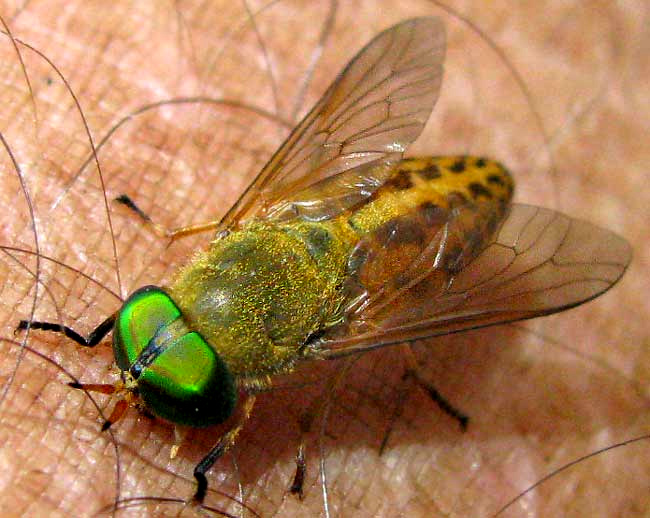
from the June 23, 2008 Newsletter, issued from the forest near Natchez, Mississippi; elevation ~400ft (120m), ~N31.47°, ~W91.29°:
GREENHEADS GALORE
Last weekend I biked to Pipes Lake {~N31.38°, ~W91.16°, elev. ~140ft (~40m)} in nearby Homochitto National Forest to test my new tent. As soon as I got there I was glad to have a tent that sealed up completely around me because horseflies were thick and eager to drill for blood, as you can see above.
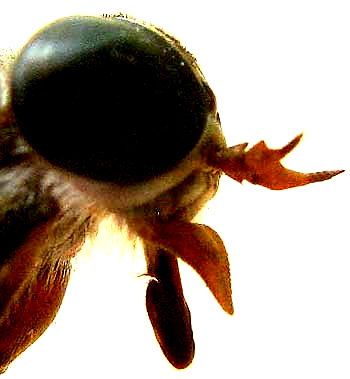 "Drill" isn't the right word. Really what they do is to cut and slice into one's flesh until blood starts flowing, then they sop up the blood with their sucking mouthparts. You can see a horsefly's mouthparts at the left.
"Drill" isn't the right word. Really what they do is to cut and slice into one's flesh until blood starts flowing, then they sop up the blood with their sucking mouthparts. You can see a horsefly's mouthparts at the left.
Horse fly mouth parts are composed of nine different parts. At the right the dark item pointed downward in the picture's bottom, center is the horsefly's mouthpart. The cylindrical section pointing downward, the labium, wraps around the slender, sharp, swordlike parts that slash into flesh, cutting across blood vessels. When blood flows to the skin's surface, then the oval, spongelike thing at the labium's base sops up the blood and the blood flows upward through the labium. The brown, triangular item between the mouthpart and the antler-like antennae pointing at the picture's right side is one of two maxillary palps, which help the fly feel and possibly smell/taste what the palps touch.
Horseflies such as greenheads suck blood for the same reasons mosquitoes do -- the females need the nutritious blood for their egg production. That means that only female horseflies bite us. Male horseflies peacefully feed on flowers. In the first horsefly picture above, notice that the two green compound eyes are completely separated from one another by a blackish band. If that were a male horsefly the eyes would touch at the front of the head, so that's how you tell a male from a female horsefly.
That horsefly's green eyes are typical of some horsefly species in the genus TABANUS and such species are commonly called greenheads. Most horseflies don't have green eyes. The green-eyed, golden-bodied one in the picture slicing into the calf of my leg is a particularly colorful one.
Last weekend at Pipes Lake the deerflies were bad, too. Sometimes they landed on my legs as I peddled mile after scorching mile down the one-lane gravel road, and fed on me as I peddled. Deerflies belong to the same family as horseflies, the Tabanidae, but they occupy a different genus. In general, deerflies are smaller than horseflies, and often their wings bear darkish zones, giving the wings a mottled effect.
Where I was, there wasn't a horse for miles around. I felt sorry for the deer and other mammals, such as myself, the horseflies and deerflies attacked.
from the July 21, 2013 Newsletter issued from the Frio Canyon Nature Education Center in the valley of the Dry Frio River in northern Uvalde County, southwestern Texas, on the southern border of the Edwards Plateau; elevation ~1750m (~5750 ft); N29.62°, W99.86°; USA
A HORSEFLY'S HEAD
Of all the places I've settled at during the last few decades, except in chilly Europe, the little Dry Frio River Valley has the least numbers of ticks, mosquitoes and biting flies. We do have prodigious numbers of stinging fire ants, but they're in a special category. Other than the fire ants, the most pestiferous critters for me personally are gnats that as soon as I settle anyplace dive-bomb into my ears and eyes.
However, lately horseflies have been moving up on the bothersome scale. Sometimes even while peddling the bicycle down the road they land on my legs and start sawing at my flesh. You can see one on my leg below:
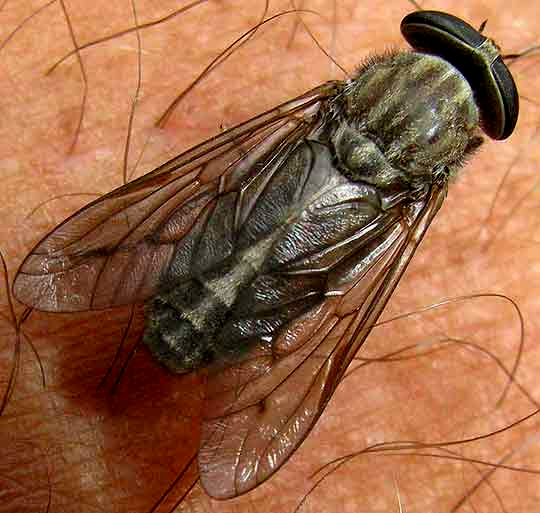
Goodwin and Drees's 1996 The horse and deer flies (Diptera: Tabanidae) of Texas tells us that just in Texas we have 109 species belonging to the Horsefly/Deerfly Family, the Tabanidae, so you can imagine that volunteer identifier Bea in Ontario couldn't go much further than to agree that our picture shows a fly in that family, except to say that "it is a 'she,' by the way, because of the space between her eyes." The compound eyes of male horseflies have no spacing between them, while you can see that our female's eyes are definitely separated. Only the females "bite," because they need nutrients in blood for their eggs.
The horsefly's compound eyes are composed of tiny units called ommatidia, and there may be as many as 30,000 of them per compound eye. Below, you can see our fly's ommatidia beneath the dissecting scope:
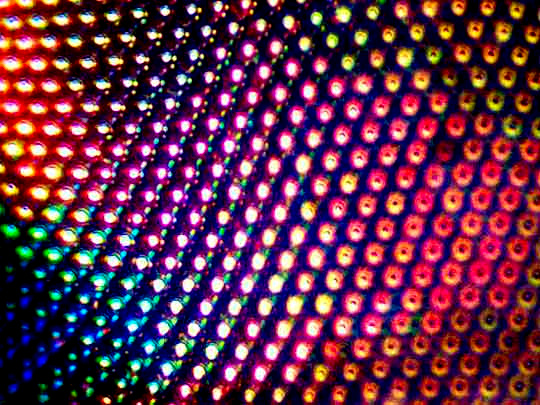
I happened to get an interesting picture of our fly's head, shown below:
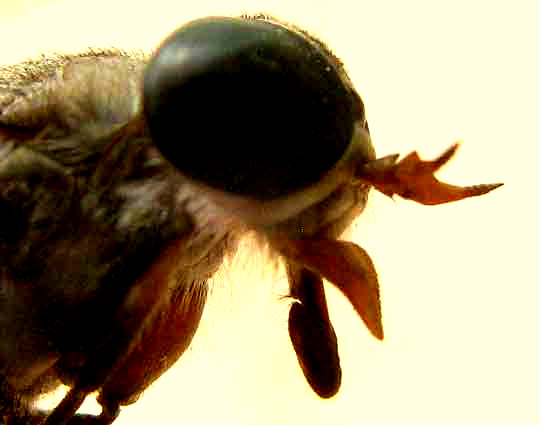
The antler-like projections pointing toward the image's right side are the antennae. The downward-directed item is the mouthpart, the labium. When a fly lands on you and sops up sweat, you can watch how he directs the labium's oval, spongy tip to this and that wet spot. The labium is like a sheath wrapping around slender, sharp blades with which the fly can slash into our flesh to get at blood. In the picture, the sharply pointed, brown item between the labium and the antennae is one of two maxillary palps, which help the fly feel and maybe smell/taste whatever they touch.
from the June 1, 2003 Newsletter, issued from near Natchez, Mississippi:
HORSEFLY ATTACKS
A Newsletter subscriber in McComb, MS writes that she understands what I was talking about a while back when I referred to these as horsefly days. "Walking in the woods is just not a whole lotta fun when you have to flail your arms or swat the air with a sweetgum limb the entire time you're walking," she writes.
She asks if horseflies are attracted to carbon dioxide the way mosquitoes are. This reminded me of a moment last weekend when I spent the night at my future base. As it began getting dark, horseflies swarmed over the white pickup truck that had taken us there, thumping into it again and again. They also hit against the barn's tin roof. The truck and barn roof weren't producing carbon dioxide, so something else was obviously the attraction. Of course the question of what attracts horseflies was made for Googling.
One Web site for fishermen provides all kinds of advice for outsmarting various blood-sucking insects -- except for horseflies. Of them it says, "Horseflies aren't smart enough to be confused. They have a steadfast mindset: find a human and bite its exposed flesh."
Another site in Canada focusing on problems canoeists face claims that "horseflies appear to be attracted visually, especially by bright or glittering surfaces. This may explain why they always appear to do their dirty work when we finish our swim and sit on the rocks, our bodies still covered in a reflective film of water." That would explain their attacking the white pickup truck and the shiny tin roof, but not their thumping into my dark mosquito net in the dim light of dawn and dusk.
Several Web sites selling insect traps using carbon dioxide as an attractant claim that just about every biting insect is attracted by carbon dioxide, including horseflies, but I'm not sure these claims can be trusted. I suspect that horseflies use a variety of cues to find their prey -- sight, odor, maybe carbon dioxide, maybe even infrared vision.
Whatever attracts horseflies, I feel sorry for their victims. A Web site in the UK claims that "50 horseflies feeding on livestock can remove 1/3 litre {quart} of blood per day." This site also points out that horseflies can transmit diseases such as the agents of anthrax (Bacillus anthracis) and tularaemia (Francisella tularensis). Plus, I can tell you that their bites hurt like the dickens!